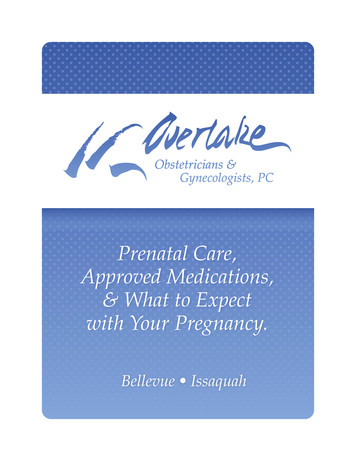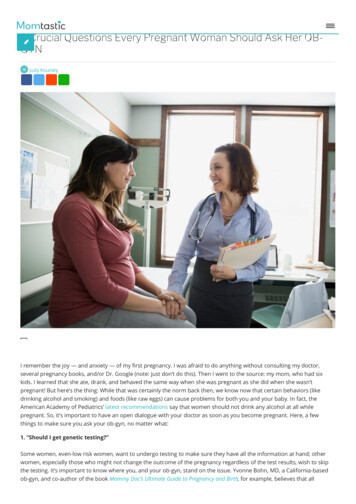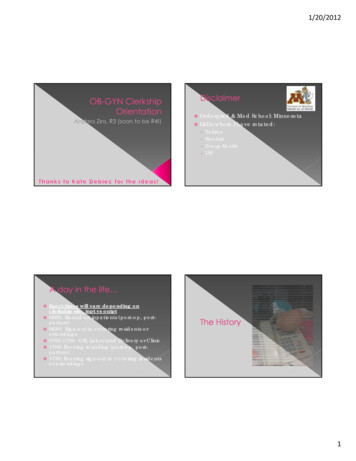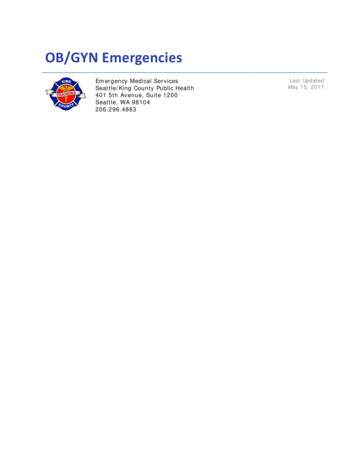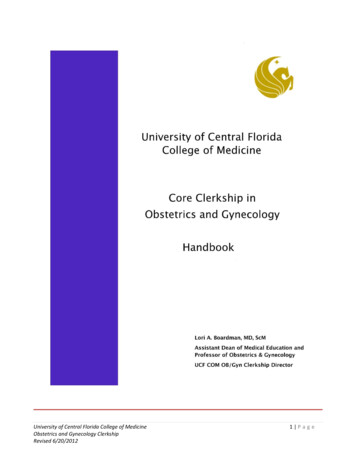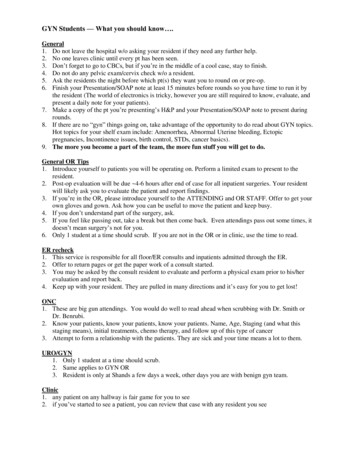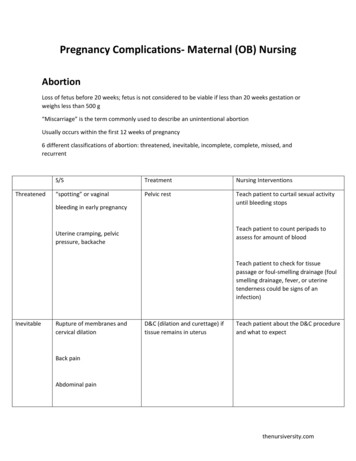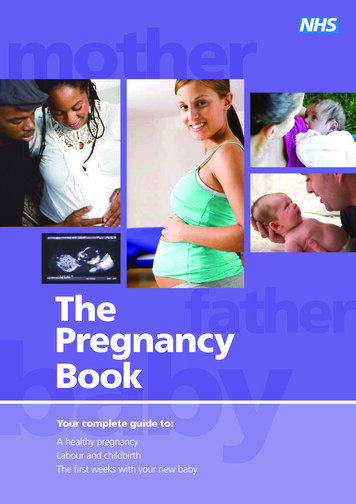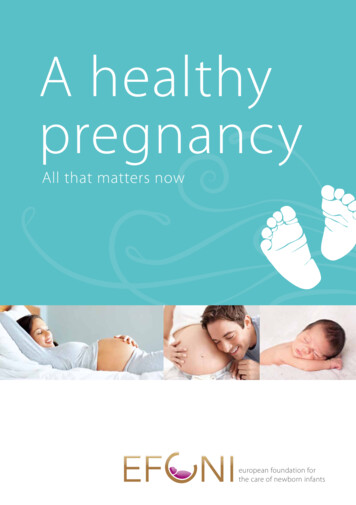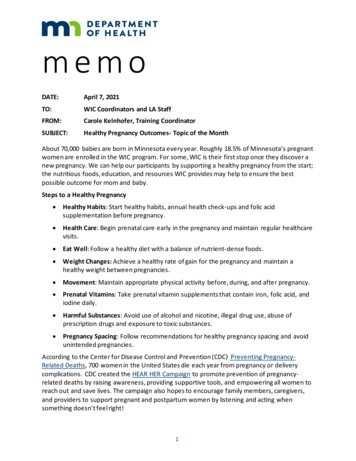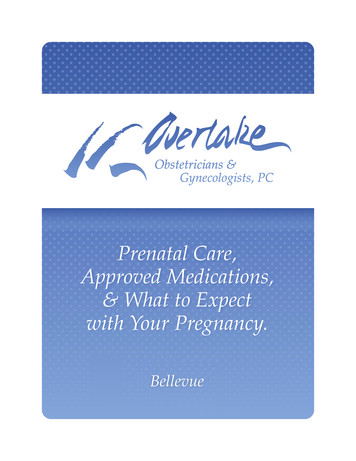
Transcription
Prenatal Care,Approved Medications,& What to Expectwith Your Pregnancy.Bellevue
Overview of Prenatal Information Your doctor delivers babies at Overlake Medical Center. This is where you will deliveryour baby. We have 9 doctors in our clinic. We have 6 female doctors and 3 male doctors. Pleasereview and sign the consent form provided before your next appointment. Weight GainPlan to gain about 25 lbs throughout your entire pregnancy§§§2-5 lbs the first 13 weeks2-5 lbs the second 13 weeks10-15 lbs the last 13 weeksToo much weight gain predisposes baby to grow up as an obese adult and giveyou increased chances of having a cesarean section.Too little weight gain and baby may not get the needed nourishment. No aspirin, Aleve, Motrin or Ibuprofen. Tylenol is okay (650mg). If you have a cold you can use saline (salt water) nasal drops or spray. Cough drops areokay, as well as cough syrup containing no more than 1.4 % alcohol (Robitussin DM). No more than a total of 6 oz of fish in one week. Absolutely no king mackerel, tile fish,sword fish, red snapper, ahi tuna, albacore tuna, or shark because mercury is a toxin andmay harm the baby. Because of the concern of listeria you should avoid deli meats, hot dogs, and soft nonpasteurized chesses i.e. goat cheese. If you do eat these foods make sure that they arecooked for at least 10 minutes. You should exercise five times every week for thirty minutes. This includes walkingapproximately 2 miles, jogging, aerobics, and gym workouts. Keep your heart rateunder 140 and don’t get short of breath. Always wear your seat belt. Floss every day. See your dentist every 6 months. This can decrease your risk forpreterm labor, premature rupture of membranes, and heart disease.
Overview of Prenatal Information continued If your water breaks or you have more than 5-6 contractions in 1 hour before your 36thweek of pregnancy, you should call our clinic. If after hours, call labor and delivery. Ifyour water breaks at any time, call our office 425-454-3366 or labor and delivery 425688-5351. You need to be taking in 1200mg of calcium every day. This can include dietary intake (4servings of dairy) and/or a calcium supplement. Your prenatal vitamin only contains200mg of calcium. You may want to consider cord blood donation. Private donation is available, as well asbanking through the Puget Sound Blood Center.
What Do I Do Next? (Directions after your first visit)1. Take your lab sheet with the Paclab symbol to Paclab for a routine obstetric blood testwithin the next couple days. Two most commonly used locations are Paclab on GilmanBlvd. in the Issaquah Medical Center on the 2nd floor. There is also a Paclab in Bellevuelocated at 1200 116th AVE NE Suite B Bellevue, WA 98004. Maps for Bellevue andIssaquah locations can be provided. You may also visit www.paclab.com for the most upto date hours and locations. Your results are sent to us and we will notify of anyabnormal results or discuss results with you at your next visit.2. Genetic Screening is optional. Read the First Trimester Handout and decide whether ornot you would like to proceed with Genetic Screening. Genetic Screening for DownsSyndrome, Trisomy 13/18 is optional. Call Eastside Maternal Fetal Medicine (Seebusiness card) to schedule this appointment between 11-13 weeks. They have twooffice locations in Bellevue 425-688-8111 or Issaquah 425-394-5021.3. There is another genetic screening test which is optional called Non-Invasive PrenatalTest (NIPT). Please read the handout provided in your packet for visit www.Counsyl.comor www.Progenity.com to read more about this optional genetic test.4. Read the “Family Prep Screen” and “nxtPanel by Progenity” brochures (in your packet)to decide whether you would like to be screened for optional carrier testing. You canalso visit the following websites for more information on these testes.a. www.Counsyl.comb. www.Progenity.com5. Please review and sign our consent confirming your understanding of our combinedfemale/male physician practice.6. Review Overlake’s packet of information regarding your birth and your stay at thehospital. Information on Childbirth classes and registration will be given to you at your15-20 week appointment.TURN IN HOSPITAL REGISTRATION BY YOUR 20th WEEK OF PREGNANCY! For Overlakeyou can mail the form to Overlake, register by phone at (425) 688-5444, or registeronline at overlakehospital.org. Then click on “patient registration.”
Insurance Coverage for Optional Obstetric TestingTo ensure if you’re insurance covers these tests, we recommend that you double check with yourinsurance company regarding coverage. The following are procedure codes that you can provide to yourinsurance and they will be able to tell you if your particular plan covers these optional genetic tests.Combined Screen (Screening for Downs Syndrome, Trisomy 13/18)Procedure Codes: Ultrasound: 76801, 76813Procedure Codes: BLOOD: 84163, 84702, 80500Carrier Testing- Carrier testing is done through Counsyl or Progenity. You can read more about youroptions by reading the pamphlet provided in your Pregnancy Folder titled “Family Prep Screen” or“Progenity nxt Panel”. Most often is recommended to screen for the 3 most common carrier diseases.Cystic Fibrosis, Fragile X and Spinal Muscular Atrophy (SMA).Counsyl Testing- Counsyl screens for the 3 most common carrier diseases (see above) as well as 99 other diseases. With insurance, cost can range from 100- 350. Without Insurance or if you prefer tocash pay- you have the option of paying a 1 time cost of 349 out of pocket. Often times, yourinsurance will cover more and you will pay less.Progenity- Progenity screens for the 3 most common types of carrier diseases (see above). Withinsurance, cost ranges from 25- 250.For the most updated information regarding cost, please reach out to the financial counselorsprovided by each company.In addition to the Combined Screening you may be offered Non Invasive Prenatal Testing (NIPT). Thereare various tests available with different prices. You can have your questions answered if you make anappointment with Eastside Maternal Fetal Medicine or by visiting the websites below.Progenity- Non Invasive Prenatal testingInsurance/Billing faqCounsyl- Informed Pregnancy egnancy-screen/
CALCIUMRDA for calcium during pregnancy is 1200 mg to 1500mg per day.Here is a list of foods that are good dietary sources of calcium.FoodMilk, Yogurt & CheeseNon fat or low-fat plain yogurtRicotta cheese, part skimSkim or low-fat milkSwiss cheeseProvolone cheeseMozzarella cheeseCheddar CheeseParmesan CheeseCottage CheeseFish, Meat, Poultry, Dried Beans, Nuts, and EggsSardines with bones, cannedAlmondsSalmon with bones, cannedTofu (firm)Black beans (cooked)Ocean perch (broiled)Blue CrabChickpeas, cannedVegetables (cooked unless otherwise specified)Kale (fresh)Mustard greensTurnip greensBok ChoyBroccoli (fresh)RutabegaFruitsOrange, grapefruit, or apple Juice(calcium fortified)Figs, driedOrangeRaisinsApricots, DriedBread, Cereal, Rice & PastaServing c10299757442418oz3005 medium1 medium½c½c15558382946833530027220720714813863
Tortillas, flourEnglish muffin, plainCorn muffin211 large1069995CALCIUM-RICH FOODS(Listed in order of highest to lowest calcium content)NON-DAIRYFortified CerealsSoy BeveragesSardinesTofuPink Salmon with BoneCollardsBlackstrap MolassesSpinachSoybeansTurnip GreensOatmealCowpeasWhite BeansKaleOkraBak-choiClamsDAIRYPlain YogurtRomano CheesePasteurized Processed SwissFruit YogurtSwiss CheeseRicottaPasteurized Processed AmericanProvoloneMozzarellaCheddarFat-Free MilkMeunster Cheese1% Low-Fat Milk2% Reduced-fat MilkReduced-fat Chocolate MilkButtermilkChocolate MilkWhole Milk
Colds and Flu in PregnancyIt is important to get a lot of rest and fluids during your pregnancy, but even more so whenyou have a cold or flu. To help with symptoms, the following may be used:1. For a headache, fever, or body aches/pains: Tylenol (Acetaminophen) 500mg,two tablets every 4-6 hours (regular or extra strength) can be used throughoutyour whole pregnancy. Do not exceed more than 8 tablets (4,000 mg) of Tylenolin a day.2. For sore throat: Halls lozenges, Chloraseptic spray, gargling with warm saltwater, or Cepacol lozenges.3. For a cough: Robitussin DM cough syrup may be taken as directed.4. For congestion (after the 8th week of pregnancy): Sudafed, original formula, orBenadryl – one at bedtime, and one during the day if needed. Saline nasal sprayis also fine.If symptoms last longer than a normal cold, you have a fever of 101.0 degrees or higherwhich is not relieved by Tylenol, severe sore throat, or chest congestion, you may need aprescription. You may call our office during regular business hours or contact your primarycare physician.Remember! Most colds are viral and have to run their course and are NOT harmful tothe baby.We recommend for all pregnant women to get the seasonal flu vaccine, which is available atyour primary care office or local pharmacy. We recommend that you receive theintramuscular injection and not the nasal spray.
Constipation in PregnancyConstipation is one of the most common side effects of pregnancy. When you’re pregnant, anincrease in the hormone progesterone causes digestion to slow, so food passes more slowlythrough the gastrointestinal tract. Other factors can contribute to constipation includingirregular eating habits, stress, changes in environment and added calcium and iron in your diet.Prevention of Constipation1. Eat High fiber foods (see list)2. Eat small, frequent meals and chew your food thoroughly3. Drink plenty of fluids, especially water. Aim for 8-12 glasses of water daily.4. Get more exercise. Adding activity to your day will help ease contstipation.In addition to increasing fiber rich foods in your diet and increasing fluid intake there are overthe counter supplements and medications which are safe to take. These include Metamucil (1tsp in 8oz of water daily) Citrucel (Capsule:2-4 capsules daily, Powder: 1tsp in 8 oz water daily) Milk of Magnesia (30-60ML once) Colace Capsules (100mg 1-2 times daily) Miralax (use as directed)List of High Fiber FoodsNavy BeansBran CerealKidney BeansSplit PeasLentilsBlack BeansPinto BeansLima BeansArtichokeWhite BeansChickpeasCowpeasSoybeansRye CrackersSweet potato with peelPearWhole Wheat BreadsBulgurRaspberriesBlackberriesPotato with skinPrunesFigsDatesPumpkinSpinachAlmondsBrussel SproutsWhole Wheat liParsnipsTurnip GreensCollardsOkraPeas
Fish Consumption in PregnancyDeciding which fish and how much fish is safe to eat while pregnant or trying toconceive is important because some contaminants can accumulate in the human bodyover time and may affect the developing fetus. The following information on fishconsumption comes from The Institute for Agriculture and Trade Policy, EnvironmentalWorking Group, and the Environmental Protection Agency.The following fish should be avoided by pregnant women:Shark, orange roughy, swordfish, king mackerel, red snapper, canned whitealbacore tuna, ahi tuna, and tile fish (sometimes sold as “white snapper” or“golden snapper”)The following fish are OK to eat 2-3 meals per week (8 ounces per serving):Farmed catfish, farmed trout (rainbow), anchovies, clams, Mid Atlantic blue crab,fish sticks (Pacific Pollock), flounder (Pacific and Atlantic), and wild Pacificsalmon, wild Alaskan salmon, canned Alaskan salmon.The following fish are OK to eat 1 meal per week (one 8 ounce serving):Pacific cod, Atlantic cod, crab (Dungeness, blue, stone), King crab, imitation crab,haddock, hake (Pacific and Atlantic), herring, mahi mahi, mussels, oysters, PacificPollock, pompano, sardines, scallops, tilapia (farmed in US), canned chunk lighttuna (canned tuna to no more than 5 ounces per week)The following fish are OK to eat 1 meal per month (one 8 ounce serving):Bluefish, crab (gulf coast blue), grouper, Pacific and Atlantic halibut, lobster,Atlantic Pollock, rockfish, tuna steaksOTHER: shrimp, the most popularly consumed seafood in the US, are generally low inmercury, but data on other contaminants are lacking.Further information on fish consumption may be found on the following /f
Ideas for Minimizing NauseaBelow you will find some tips to help decrease nausea and vomiting. Unfortunately, we cannotalways entirely eliminate nausea and vomiting. In severe cases, we may use a prescriptionmedication to help. The important thing to remember with nausea and vomiting is that it isimportant for you to stay hydrated. If you are unable to keep fluids down for more than8 hours, please call our office or go into an emergency room for IV hydration.1. Be sure to get enough fluids .Dehydration is a danger to those with nausea, so it is important to stay hydrated. Some womenfind they tolerate fluids best with meals; others find it better to take them only between meals.Small sips, taken frequently, may also help. Remember, fruit juices are a simple carb and maycause a quick surge and then crash in some women, so try to use water instead (or at least takea protein with your fruit juice). If fluids give you a lot of trouble, try fruits and vegetables with highwater content. Other sources of fluids include soup, Popsicles, ice chips, and jell-o. Gatorade isalso a good choice. Also, avoid hot or cold fluids/food. Luke warm or room temperature fluidstend sit better in the stomach.2. Keep your blood sugar levels even by eating sm all, frequent m eals highin protein and com plex carbohydrates .Simple carbohydrates (foods high in sugar and even unsweetened fruit juice) are turned quicklyinto blood sugar in your system. Complex carbohydrates take longer to turn into blood sugar, sothey will keep your blood sugars from spiking quickly and then dropping, and will provide longerterm energy. High fiber foods, fats, and proteins also slow down the carbohydrate conversion,which will keep your blood sugar more even. Never eat carbohydrates without an accompanyingfat or protein food. Frequent small snacks work better for nausea than big meals. Try eating 56 small meals or snacks a day, and be sure to eat before bedtime. Also, carry withyou a portable snack such as nuts and fruit or cheese and crackers for use if youstart feeling nauseous ---even though it's very hard to try and eat when you feel queasy, youmay be able to prevent a worse nausea episode if you do get something down.3. Eat before you are hungry .If you wait until your body tells you it is hungry, you may already have lowered your blood sugartoo much and the acid production in your stomach may also worsen the nausea. Strike first byeating frequent small snacks (a carbohydrate and a protein are best) before your blood sugar hasa chance to dip. Also, eating while you are still feeling relatively good will help food go down andperhaps stay down, and may prevent a nausea attack. Try not to let more than 3-4 hoursgo by between eating something.4. Eat a substantial bedtim e snack, including protein.It's a long time between your last meal of the day and your breakfast the next morning, so it's veryeasy for blood sugar to become too low during this time, causing nausea upon rising. Shortlybefore bedtime, try eating a fairly significant snack of complex carbohydrates and protein. Theprotein will help slow down the release of the complex carbohydrates, enabling you to havesteadier blood sugar levels through the night. Sometimes, some women even need to get up inthe middle of the night and get a little extra snack, like a glass of milk, in order to help theirmorning nausea.5. Try eating before getting out of bed in the m orning, and then take itslowly.
Before getting out of bed in the morning, have a high-carbohydrate snack. Common suggestionsare crackers, but some women find other foods work better. Experiment till you find your bestchoice (some like salty foods, others do not). Once you are up, ease yourself into the day asgradually as your schedule allows; rushing and quick movements at first tend to aggravatenausea. Give the morning snack a chance to take effect and raise your blood sugar.6. Try the BRAT diet.Try eating bland or mild foods. Good examples are bananas, rice, applesauce, and toast. Avoidusing spices or additional seasonings.7. Avoid trigger foods and substitute alternatives as needed; get enoughprotein.Some foods seem to act as triggers to nausea. Don't forget the importance of significant amountsof protein in your diet as well---it is recommended to have 80-100 g of protein per day (butremember that foods like milk, yogurt, and even spinach do have protein in them and countstowards this total).8 . Try ginger.Studies have shown that ginger can reduce nausea. Ginger ale and ginger tea are excellentchoices. Ginger candies are also available. Avoid ginger extract or ginger pills because theseare concentrated supplements and are not known to be safe.9. Try pepperm int.Peppermint can be very soothing and reduce nausea. Peppermint tea or peppermint candies areoften helpful.10. Try hard candies.Sucking on hard candies can often reduce nausea. Peppermint or ginger candies are particularlygood, but any kind will do. Sugar-free is also a good choice.11. Be sure to take your prenatal vitam in, but try switching brands ortim es.Some women note sensitivity to certain prenatal vitamin brands, especially the prescription type.Try switching for a week to an over-the-counter brand (be sure it has enough folic acid), or tryasking your doctor for a different prescription type. Sometimes changing the time of day that youtake the vitamin can help---try taking it at the time of day when you have the least nausea.Bedtime may be a good choice. You can also stop your vitamin for a week and if this decreasesyour nausea, try taking one Flintstones Vitamin twice a day. Once you are feeling better yourprenatal vitamin can be restarted.12. Try taking Vitam in B6.Some women find relief if they add extra vitamin B-6 to their diet. 50 mg is usually the dosagestried, but remember to clear it first with your health provider. Try taking 50mg twice daily.13. Ask your healthcare provider about trying Unisom .One half of a tablet of Unisom (Over the counter sleep aid) at night has shown to help improvenausea. Be sure to check with your healthcare provider first. Some women find good relief frompairing ½ tablet of Unisom with 50mg of Vitamin B6 at bedtime.14. Rinse or brush after vom iting.Try brushing your teeth after vomiting, but if you are one of the people for whom brushing caninduce nausea, try a gentle rinsing instead. Over time you will find your physical triggers (such asbrushing, strong smells, or moving too fast) and you will learn to avoid them or adapt to them.15. Try Sea Bands.
These small bands worn on each wrist put pressure on the inner wrist and often help nausea.They have no side effects and can be found at many pharmacies or marine shops.IRON RICH FOODSEXCELLENT SOURCES:KidneyLiverPrune JuiceOystersMusselsCereals such as:Cream of WheatMalt-O-MealTotalBran FlakesQuinoaRaisin BranProduct 19Fortified Oat FlakesFortified OatmealWheat germPinto beansSpaghettiPorkTroutMaypoWheat ChexSpecial KKixCheeriosWheatiesVERY GOOD SOURCES:Canned mackerelHeartLiverwurstDark turkey meatLean beef (flank steak)ClamsBaked potatoCereals such as:
GOOD SOURCES:Dried beans (kidney,lima)AsparagusDried prunesBagelChickenFAIR SOURCESDried apricotsBananaBrussel sproutsPeasCanned plumsEnriched white breadNutsCocoaPeanut ButterRaisinsDatesFigsSpinachGreen BeansBeetsMustardTurnipsChardCorn TortillaEgg YokesDark MolassesGarbanzo BeansPicklesTomato JuiceBerriestuna
Group B streptococcus (G
1. Take your lab sheet with the Paclab symbol to Paclab for a routine obstetric blood test within the next couple days. Two most commonly used locations are Paclab on Gilman Blvd. in the Issaquah Medical Center on the 2nd floor. There is also a Paclab in Bellevue located at 1200 116th
